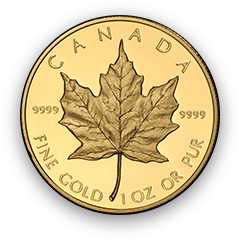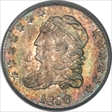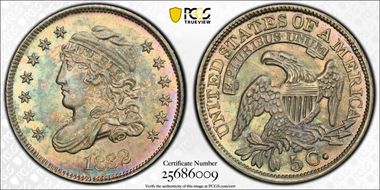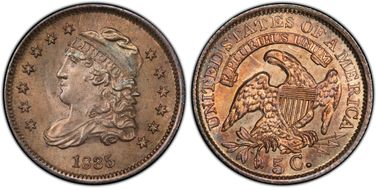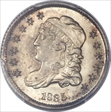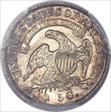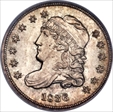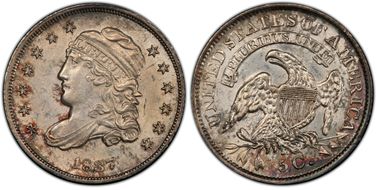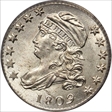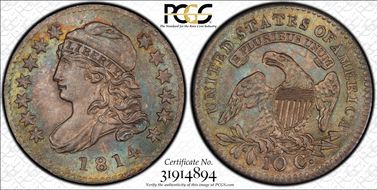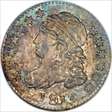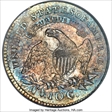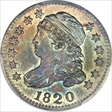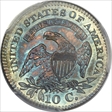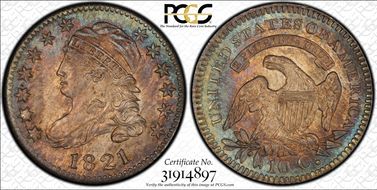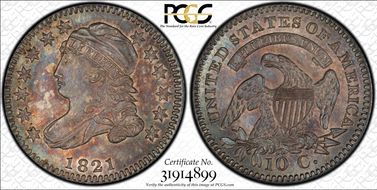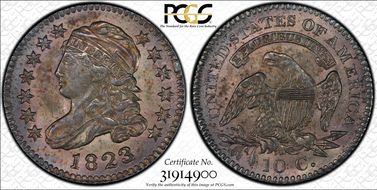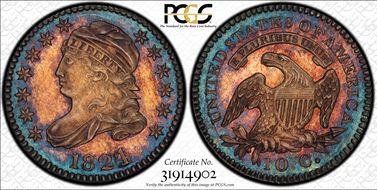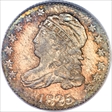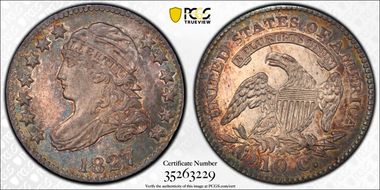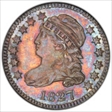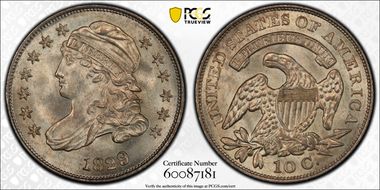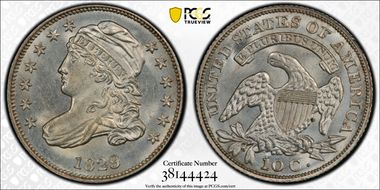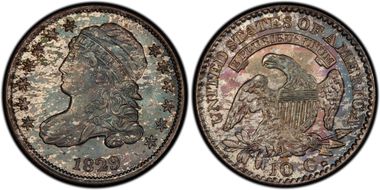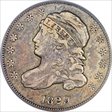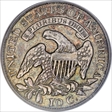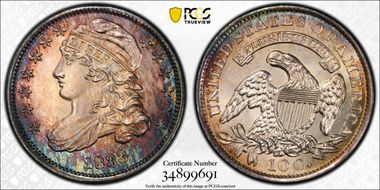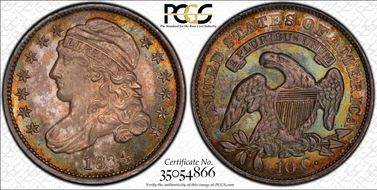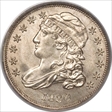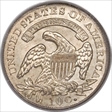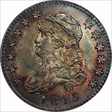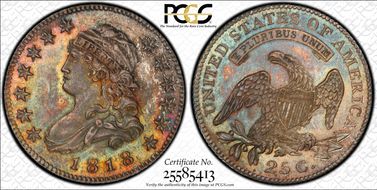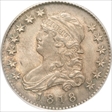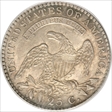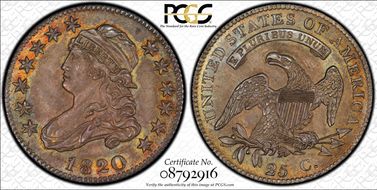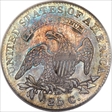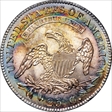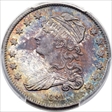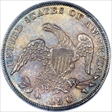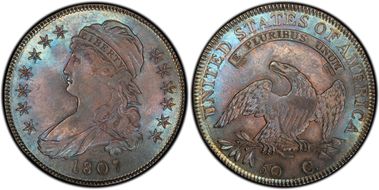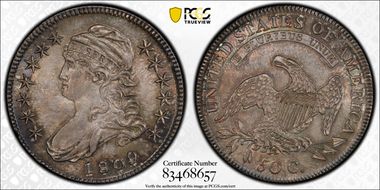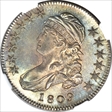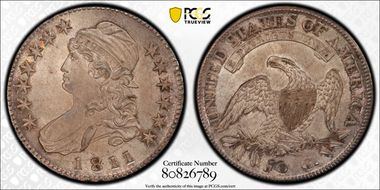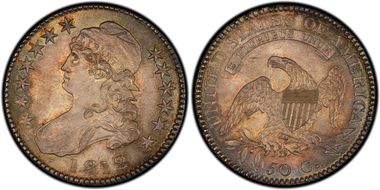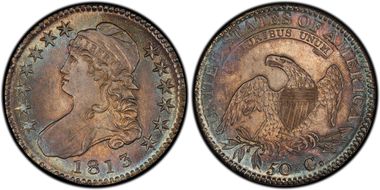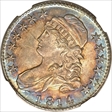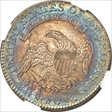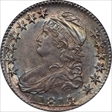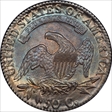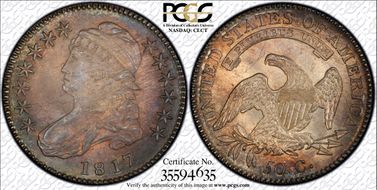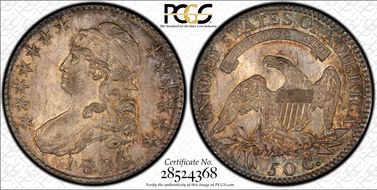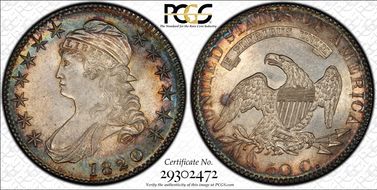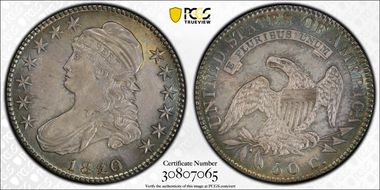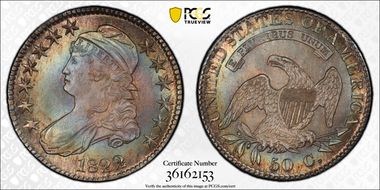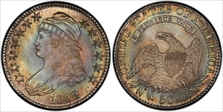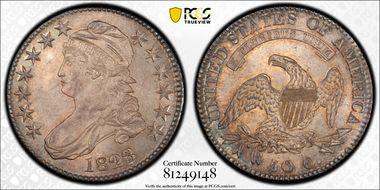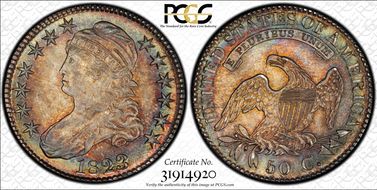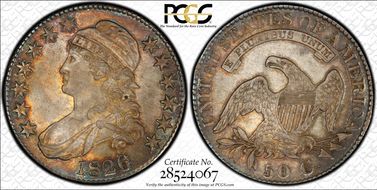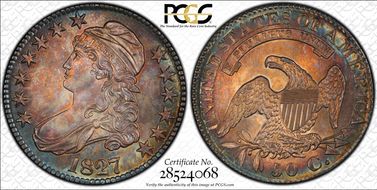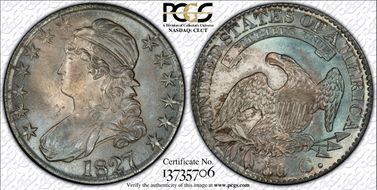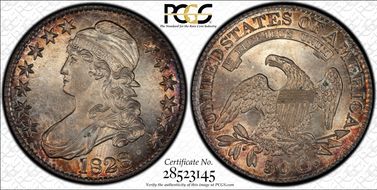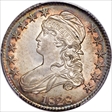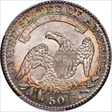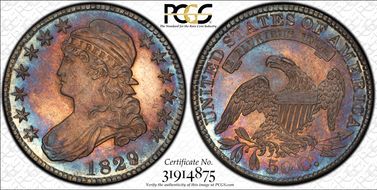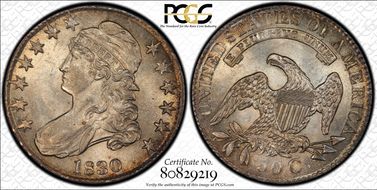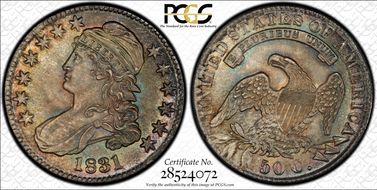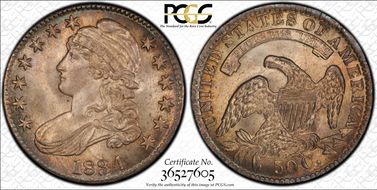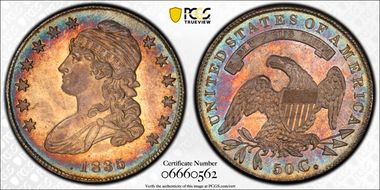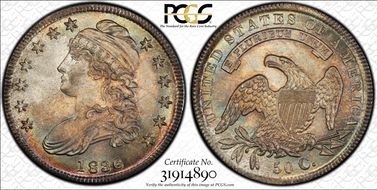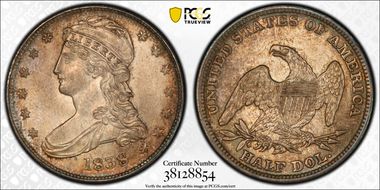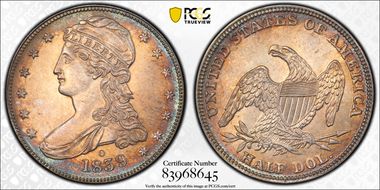The Link Early American Silver Capped Bust Complete Series Set Coin Album
LM-12 R4. Lovely colorful, blazing luster, nice strike. Obtained from the heritage Auction #1214 of the Eugene Gardener Collection on 10/27/2014, Lot 98174.
LM-12 R4. Lovely colorful, blazing luster, nice strike. Obtained from the heritage Auction #1214 of the Eugene Gardener Collection on 10/27/2014, Lot 98174.
LM-10.1 R.3. CAC. Tied Finest Known 1832 Half Dime. Per cataloger, "V-13, LM-10.1, R.3, MS67+ PCGS. CAC. Faint die clashing at the throat and ear identify the LM-10.1 variety. Star 3 is lightly repunched, and the O in OF is broadly recut at the top (the Logan-McCloskey reference describes it as a Small O over a broken Large O). Three remarriages of the LM-10 dies plus the original pairing (LM-10.1) make this variety an interesting die study. The obverse fields of the current example are prooflike, although the reverse is more frosted and negates a prooflike designation. Delightful multicolor toning covers both sides, with pink, blue, and peach-gold shades grabbing the most attention. The strike is razor-sharp. Among all Capped Bust half dimes, the 1832 is the second-most available date (behind the 1835 issue), yet in Plus-graded MS67 this coin is arguably the second-finest known." Obtained from Heritage Auction on September 17, 2015, Lot 3787.
LM-10 R1. "Small Date, Small 5C, V-7, LM-10, R.1, MS66 PCGS. A fully struck and coruscating Premium Gem. The fields and motifs are lightly toned, but the borders exhibit autumn-brown and jade-green. A refreshingly unabraded and exceptionally attractive Capped Bust type coin. One of two Small Date, Small 5C Valentine varieties, distinguished by the die break at the upper half of the second S in STATES," per Heritage cataloger. obtained from Heritage Summer FUN US Coins Signature Auction - Orlando #1207 on Julay 10, 2014, Lot 3661.
LM-10 R1. "Small Date, Small 5C, V-7, LM-10, R.1, MS66 PCGS. A fully struck and coruscating Premium Gem. The fields and motifs are lightly toned, but the borders exhibit autumn-brown and jade-green. A refreshingly unabraded and exceptionally attractive Capped Bust type coin. One of two Small Date, Small 5C Valentine varieties, distinguished by the die break at the upper half of the second S in STATES," per Heritage cataloger. obtained from Heritage Summer FUN US Coins Signature Auction - Orlando #1207 on Julay 10, 2014, Lot 3661.
LM-5 R2. Gardner. CAC. Per cataloger, "One of the finest examples known. As usual, the reverse die is rotated counterclockwise by approximately 30 degrees. This is a beautiful Premium Gem, one of the finest-known examples, with intense mint luster and bright silver surfaces that display a bit of attractive light gold toning near the obverse and reverse peripheries." Obtained form Heritage Auction #1214 of the Eugene Gardner Collection on October 27, 2014, Lot 98177.
LM-5 R2. Gardner. CAC. Per cataloger, "One of the finest examples known. As usual, the reverse die is rotated counterclockwise by approximately 30 degrees. This is a beautiful Premium Gem, one of the finest-known examples, with intense mint luster and bright silver surfaces that display a bit of attractive light gold toning near the obverse and reverse peripheries." Obtained form Heritage Auction #1214 of the Eugene Gardner Collection on October 27, 2014, Lot 98177.
LM-4 R3. Light tan peripheral toning. Obtained by private treaty with David Sunshine on December 1, 2019.
JR-1 R.3+. OGH. Larry Miller. Jason Carter at Stacks Bowers said it "the best I've ever seen". Per Stacks cataloger, "One of only two 1809 dimes to have received an MS-66 grade from the major third party certification services, with none finer, our offering of the Larry H. Miller specimen represents an exceedingly rare bidding opportunity for advanced collectors. This is a delightful premium Gem example, both sides brilliant with a bright satin texture. Softness to the first four stars is typical of the issue, the detail otherwise boldly to sharply rendered from a well centered strike. Virtually pristine, a faint planchet streak above the digit 8 in the date and a tiny reverse mark below the letter E in UNITED are the most useful identifiers for establishing the provenance of this important condition rarity. In 1808 no dimes were struck and when production resumed in 1809 the denomination featured the popular Capped Bust design by John Reich. The mintage is 51,065 pieces, all struck using a single pair of dies. These coins were delivered in five separate batches, three during 1809 and the final two on June 6 and December 17, 1810. No dimes were struck from 1810-dated dies. Two distinct die states are known for the 1809, the earlier (and rarer) state with both As in AMERICA open, and the later with the tops of both of those letters filled. On the present example the top of the first A is completely filled while the top of the second A is open. Unlike most other first year U.S. coins, the 1809 was not saved to an appreciable extent, which is not surprising since there were few numismatists active in the United States early in the 19th century. In fact, the 1809 is one of the scarcer issues in the Large Diameter portion of the Capped Bust dime series. Of the 200 to 300 coins believed extant in all grades, only 20 or so are Uncirculated (these estimates per Winston Zack, Louis Scuderi and Michael Sherrill in the 2015 reference Bust Dime Variety Identification Guide). The present example is tied for CC#1 with only one other grading event in PCGS MS-66, and it is making its first known auction appearance in the modern market. Provenance: Larry Miller Collection." PCGS pop 2 none finer. Obtained from Stacks Bowers Auction of the Larry Miller Collection Part 2 on December 17, 2020, Lot 1048.
JR-1 R.3+. OGH. Larry Miller. Jason Carter at Stacks Bowers said it "the best I've ever seen". Per Stacks cataloger, "One of only two 1809 dimes to have received an MS-66 grade from the major third party certification services, with none finer, our offering of the Larry H. Miller specimen represents an exceedingly rare bidding opportunity for advanced collectors. This is a delightful premium Gem example, both sides brilliant with a bright satin texture. Softness to the first four stars is typical of the issue, the detail otherwise boldly to sharply rendered from a well centered strike. Virtually pristine, a faint planchet streak above the digit 8 in the date and a tiny reverse mark below the letter E in UNITED are the most useful identifiers for establishing the provenance of this important condition rarity. In 1808 no dimes were struck and when production resumed in 1809 the denomination featured the popular Capped Bust design by John Reich. The mintage is 51,065 pieces, all struck using a single pair of dies. These coins were delivered in five separate batches, three during 1809 and the final two on June 6 and December 17, 1810. No dimes were struck from 1810-dated dies. Two distinct die states are known for the 1809, the earlier (and rarer) state with both As in AMERICA open, and the later with the tops of both of those letters filled. On the present example the top of the first A is completely filled while the top of the second A is open. Unlike most other first year U.S. coins, the 1809 was not saved to an appreciable extent, which is not surprising since there were few numismatists active in the United States early in the 19th century. In fact, the 1809 is one of the scarcer issues in the Large Diameter portion of the Capped Bust dime series. Of the 200 to 300 coins believed extant in all grades, only 20 or so are Uncirculated (these estimates per Winston Zack, Louis Scuderi and Michael Sherrill in the 2015 reference Bust Dime Variety Identification Guide). The present example is tied for CC#1 with only one other grading event in PCGS MS-66, and it is making its first known auction appearance in the modern market. Provenance: Larry Miller Collection." PCGS pop 2 none finer. Obtained from Stacks Bowers Auction of the Larry Miller Collection Part 2 on December 17, 2020, Lot 1048.
JR-1 R3. CAC. Attractive original surfaces surrounded by colorful album toning.
JR-1 R3. CAC. Pogue. Finest Known 1814 Small Date Dime. Striking visual eye appeal with original surfaces infused with color. Obtained from Stacks Bowers' Auction of the D. Brent Pogue Collection Part 3 on February 9, 2016.
JR-3 R2. Gardner. CAC. Per Heritage Gardner cataloger, "JR-3, R.2, MS66 NGC. Deep violet and pale peach patina with blue accents covers each side of this nicely preserved Premium Gem dime, boldly struck from late-state dies that show prominent die clashing and some moderate signs of die fatigue, most prominent in the left obverse field. Numerous die cracks appear on the reverse, crisscrossing within the shield and running from D in UNITED to P in PLURIBUS to the eagle's beak. This is an extremely attractive example, almost surely within the Condition Census for the variety at this grade level, even though it is generally available in lower grades. Variety: JR-3, R.2. Large Date, curl extends to right edge of second 1 in the date. No period after 10 C. Population Data (3/15): For all 1814 dime varieties, NGC shows 14 in MS66 with three MS67 finer. The finest JR-3 dimes at NGC are one each in MS66 and MS67. PCGS shows one 1814 Large Date dime in MS66, variety unspecified. Heritage Commentary: The dimes of 1814 are usually broken down into Small Date (JR-1), Large Date (JR-2, JR-3, JR-4) and STATESOF, for example in the Guide Book. Due to the fairly recent phenomenon of variety attribution at the two major grading services, the population data can be tricky and not terribly reliable, but this piece, as we suspected above, still seems solidly within the Condition Census. Provenance: Boys Town (Bowers and Merena, 3/1998), lot 527." Crossed by Jason Carter PCGS MS66. Obtained by private treaty with Jason Carter on July 4, 2015.
JR-3 R2. Gardner. CAC. Per Heritage Gardner cataloger, "JR-3, R.2, MS66 NGC. Deep violet and pale peach patina with blue accents covers each side of this nicely preserved Premium Gem dime, boldly struck from late-state dies that show prominent die clashing and some moderate signs of die fatigue, most prominent in the left obverse field. Numerous die cracks appear on the reverse, crisscrossing within the shield and running from D in UNITED to P in PLURIBUS to the eagle's beak. This is an extremely attractive example, almost surely within the Condition Census for the variety at this grade level, even though it is generally available in lower grades. Variety: JR-3, R.2. Large Date, curl extends to right edge of second 1 in the date. No period after 10 C. Population Data (3/15): For all 1814 dime varieties, NGC shows 14 in MS66 with three MS67 finer. The finest JR-3 dimes at NGC are one each in MS66 and MS67. PCGS shows one 1814 Large Date dime in MS66, variety unspecified. Heritage Commentary: The dimes of 1814 are usually broken down into Small Date (JR-1), Large Date (JR-2, JR-3, JR-4) and STATESOF, for example in the Guide Book. Due to the fairly recent phenomenon of variety attribution at the two major grading services, the population data can be tricky and not terribly reliable, but this piece, as we suspected above, still seems solidly within the Condition Census. Provenance: Boys Town (Bowers and Merena, 3/1998), lot 527." Crossed by Jason Carter PCGS MS66. Obtained by private treaty with Jason Carter on July 4, 2015.
JR-5. R.3. CAC. Finest Known. Lovely original toning. Ex: Heritage Auction of the Eugene Gardner Collecton on May, 2015, Lot 8211. Obtained by private treaty with David Quint on Febuary 1, 2018.
JR-1 R3. STATESOF. CAC. Gardner, Quint. Finest Known. Per Heritage cataloger of the Eugene Gardner in 2014, "The obverse is prooflike and highly lustrous, with frosted motifs surrounded by exquisite toning. The reverse is equally appealing -- but less prooflike -- and frosty. A full strike is evident everywhere except stars 2, 3, 13, and the top dentils, the result of a visible die bulge from the late die state. The reverse is fully struck except at the top dentils. Radiant luster highlights concentric toning bands of brilliant-blue and yellow-green around orange-gold centers." About ten are known in mint state. Obtained by private treaty from David Quint on January 8, 2018.
JR-1 R3. STATESOF. CAC. Gardner, Quint. Finest Known. Per Heritage cataloger of the Eugene Gardner in 2014, "The obverse is prooflike and highly lustrous, with frosted motifs surrounded by exquisite toning. The reverse is equally appealing -- but less prooflike -- and frosty. A full strike is evident everywhere except stars 2, 3, 13, and the top dentils, the result of a visible die bulge from the late die state. The reverse is fully struck except at the top dentils. Radiant luster highlights concentric toning bands of brilliant-blue and yellow-green around orange-gold centers." About ten are known in mint state. Obtained by private treaty from David Quint on January 8, 2018.
JR-2 R.3. CAC. Finest known. Secure. The famous Office Boy variety. Silky smooth nearly perfect original surfaces with a kaleidoscope of attractive color. One of the top two large sized capped Bust Dimes ever graded by PCGS. "Apple-green and rose-red adorn the obverse of this lustrous and immaculate Superb Gem. The reverse exhibits aquamarine, violet, and autumn-gold shades. The strike is intricate aside from occasional slight incompleteness on the dentils. Among the 13 1820 die marriages, only JR-2 and JR-3 have a small 0 in the date, as they were struck from the same obverse die. JR-2 is readily distinguished from JR-3 by its blundered UNITED STATES OF AMERICA. The first S in STATES is lightly but widely repunched. The O in OF is repunched south, and the M in AMERICA is repunched west. It appears that the second S in STATES was initially entered retrograde, since an errant serif is visible at the lower right corner. The obverse is better engraved despite minor repunching on the final star. The Dime Book calls JR-2 "very popular among collectors because of the spectacular "Office Boy" recuttings. Although such die worker errors likely embarrassed the Mint in 1820, today they are viewed favorably. The lettering mistakes add a rustic charm, and also simplify attribution. The present high grade example is from a late die state with a double set of clash marks near the beak and light clash marks beneath Liberty's ear and at the tip of her upper ribbon. JR-2 is a conditionally rare variety. A search of our auction archives locates no prior appearances finer than MS65. Among those certified as JR-2 by PCGS, the present piece is finest by three grades. At NGC, the single finest as JR-2 is graded MS66. Thus, this lot may be the highest graded example of the variety. Certainly, it is difficult to believe that another may be of equal quality. From The Collection of Oliver Jung," per Heritage cataloger. Obtained from Heritage's ANA US Coins Signature Auction - Chicago #1208 on August 7, 2014, Lot 5561.
JR-2 R.3. CAC. Finest known. Secure. The famous Office Boy variety. Silky smooth nearly perfect original surfaces with a kaleidoscope of attractive color. One of the top two large sized capped Bust Dimes ever graded by PCGS. "Apple-green and rose-red adorn the obverse of this lustrous and immaculate Superb Gem. The reverse exhibits aquamarine, violet, and autumn-gold shades. The strike is intricate aside from occasional slight incompleteness on the dentils. Among the 13 1820 die marriages, only JR-2 and JR-3 have a small 0 in the date, as they were struck from the same obverse die. JR-2 is readily distinguished from JR-3 by its blundered UNITED STATES OF AMERICA. The first S in STATES is lightly but widely repunched. The O in OF is repunched south, and the M in AMERICA is repunched west. It appears that the second S in STATES was initially entered retrograde, since an errant serif is visible at the lower right corner. The obverse is better engraved despite minor repunching on the final star. The Dime Book calls JR-2 "very popular among collectors because of the spectacular "Office Boy" recuttings. Although such die worker errors likely embarrassed the Mint in 1820, today they are viewed favorably. The lettering mistakes add a rustic charm, and also simplify attribution. The present high grade example is from a late die state with a double set of clash marks near the beak and light clash marks beneath Liberty's ear and at the tip of her upper ribbon. JR-2 is a conditionally rare variety. A search of our auction archives locates no prior appearances finer than MS65. Among those certified as JR-2 by PCGS, the present piece is finest by three grades. At NGC, the single finest as JR-2 is graded MS66. Thus, this lot may be the highest graded example of the variety. Certainly, it is difficult to believe that another may be of equal quality. From The Collection of Oliver Jung," per Heritage cataloger. Obtained from Heritage's ANA US Coins Signature Auction - Chicago #1208 on August 7, 2014, Lot 5561.
JR-2 R6+. CAC. Pogue and Quint. Extremely rare. Tied Finest Known 1821 Dime. Monumental die marriage rarity of the Capped Bust dime series. Fantastic originality, luster, color and eye appeal. Really surprising to find such a high quality coin example of one of the keys to the series. Beloved by its previous owner David Quint who assembled the finest die marriage set of Capped Bust Dimes ever.
JR-9 CAC. Small Date. Terrific color and eye appeal with strong luster. Tied for Finest Known 1821 Dime.
JR-1 R3. CAC. Pogue. Lovely original toning and cartwheel luster.
JR-2 R2. CAC. Eliasberg Gardner. Lot 98213. Per cataloger, "1825 Dime, JR-2, Pristine MS66. Ex: Eliasberg, Sole Finest at CAC. 1825 10C JR-2, R.2, MS66 PCGS. CAC. Ex: Eliasberg. This Premium Gem 1825 dime, certified in an old PCGS green-label holder with the CAC green bean and the Eliasberg pedigree, is a coin of marvelous quality. Pearl-gray central devices cede to rose-orange in the fields and finally to glints of amber, mint, and pale blue at the rims. As expected at this grade level, there are simply no distractions on the surfaces. This piece is tied for the 1825 date with three other submissions for the finest at PCGS -- but obviously the only one with the important Eliasberg pedigree, and described in that catalog as "probably the finest known." Variety: JR-2, R.2. The right side of the 2 in the date is under the lowest hair curl. The E in UNITED is above the T, and 10 C is high in the field. Population Data (3/15): As noted above, this piece is tied for the finest 1825 dime at PCGS with three others in MS66. The finest certified JR-2 at NGC is only MS62. NGC reports four MS66 1825 dimes as finest. This is the sole (and finest) MS66 1825 dime with the CAC green approval sticker. Heritage Commentary: Described in the Eliasberg catalog thusly: "Superb surfaces with satiny lustre and deep rose toning gradually giving way to blue and amber at the borders. Slight weakness among central details." The piece brought $12,100 in the Eliasberg sale -- what a bargain! Provenance: Louis E. Eliasberg, Sr.; Eliasberg Collection (Bowers and Merena, 5/1996), lot 1075; Goldbergs (6/2002), lot 2122." Obtained from Heritage Auction of the Eugene Gardner Collection on May 12, 2015, Lot 98213.
JR-2 R2. CAC. Eliasberg Gardner. Lot 98213. Per cataloger, "1825 Dime, JR-2, Pristine MS66. Ex: Eliasberg, Sole Finest at CAC. 1825 10C JR-2, R.2, MS66 PCGS. CAC. Ex: Eliasberg. This Premium Gem 1825 dime, certified in an old PCGS green-label holder with the CAC green bean and the Eliasberg pedigree, is a coin of marvelous quality. Pearl-gray central devices cede to rose-orange in the fields and finally to glints of amber, mint, and pale blue at the rims. As expected at this grade level, there are simply no distractions on the surfaces. This piece is tied for the 1825 date with three other submissions for the finest at PCGS -- but obviously the only one with the important Eliasberg pedigree, and described in that catalog as "probably the finest known." Variety: JR-2, R.2. The right side of the 2 in the date is under the lowest hair curl. The E in UNITED is above the T, and 10 C is high in the field. Population Data (3/15): As noted above, this piece is tied for the finest 1825 dime at PCGS with three others in MS66. The finest certified JR-2 at NGC is only MS62. NGC reports four MS66 1825 dimes as finest. This is the sole (and finest) MS66 1825 dime with the CAC green approval sticker. Heritage Commentary: Described in the Eliasberg catalog thusly: "Superb surfaces with satiny lustre and deep rose toning gradually giving way to blue and amber at the borders. Slight weakness among central details." The piece brought $12,100 in the Eliasberg sale -- what a bargain! Provenance: Louis E. Eliasberg, Sr.; Eliasberg Collection (Bowers and Merena, 5/1996), lot 1075; Goldbergs (6/2002), lot 2122." Obtained from Heritage Auction of the Eugene Gardner Collection on May 12, 2015, Lot 98213.
JR-1 1827/7 R2. Eliasberg, Gardner, Quint and DL Hansen pedigree. Tied Finest Known 1827 Dime. Far and away the highest graded 1827/7 dime. This is a very tough redbook variety in mint state. Original toning with moderate luster for grade. Obtained by trade with Del Roy Hansen on January 24, 2018.
JR-1 R2. CAC. Eliasberg and Gardner. Stunning original surfaces with cartwheel luster. Obtained from Heritage Auction #1214 of the Eugene Gardner Collection on October 27, 2014.
JR-7 R.1. CAC. Tied Finest Known 1829 Small 10C Dime. Ex: Oliver Jung "The Type Set". Coin has flashy blast white appearance with strong cartwheel luster. Nearly perfect undisturbed surfaces. Obtained by private treaty with Laura Sperber at Legend Numismatics on September 6, 2019.
JR-9 R.4. Finest Known. Per cataloger, "Prooflike fields. Small Over Large 10C, JR-9, FS-901, R.4, MS65 PCGS. The denomination 10C is punched over the remnants of another, larger 10C on this Square Base 2 variety reverse. PCGS records four Mint State examples of this variety, of which the present is the finest. Additional pieces may exist unattributed. This Gem is razor-sharp throughout the obverse, with trivial weakness on the eagle's head on the reverse. The fields are prooflike, and there is the faintest trace of light golden tinting. Neither side exhibits mentionable distractions, earning this coin tremendous eye appeal, which is befitting of the grade. Population: 1 in 65, 0 finer (11/19)." Obtained from Heritage Auction #1311 on January 9, 2020, Lot 4149.
JR-2 R3. CAC. Large 10c. Tied Finest Known 1829 Dime. Per cataloger, "1829 Large 10C Dime, JR-2, MS67 Tied for Finest Known. 1829 10C Large 10C, JR-2, R.2, MS67 PCGS. CAC. Although not truly rare, JR-2 is one of the less often seen 1829 dime varieties in Mint State grades, and it is the only die pairing in the Large 10C type. Of the different denomination size types, the Small 10C is the most frequently encountered in Mint State due largely to a high number of varieties that comprise that type; the Medium 10C type closely follows, with the Large 10C variety (JR-2) rare in Uncirculated condition and the Extra Large 10C variety (JR-1) almost unobtainable at this level. This magnificent coin is not only one of the finest JR-2 dimes known, but it is also tied with just four others as the finest 1829 dime certified at PCGS, regardless of variety (4/15). Both sides show irregular splashes of deep aquamarine and violet toning over light champagne surfaces, while close study with a loupe fails to reveal any discernible abrasions. Minor striking weakness is noted on the eagle's head and talons and select hair curls, not unusual for the issue and type. An outstanding coin that will impress the most discerning numismatist.
JR-5 R1. CAC. Pogue. Finest Known Small Size Capped Bust Dime. Finest Known 1831 Dime. How exactly does this coin exist one might ask? Breathtaking color, luster with essential perfect surfaces. Flashlight luster and wow!
JR-1 R2. CAC. Light pewter toning with yellow-green highlights and solid luster. Obtained from Pinnacle Rarities on March 7, 2014
JR-1 R2. CAC. Light pewter toning with yellow-green highlights and solid luster. Obtained from Pinnacle Rarities on March 7, 2014
JR-10 R.3. CAC. Finest Known 1833 Dime. Cartwheel luster with pristine surfaces. Lovey visual appeal with peripheral color toning and central golden tan toning. Obtained by private treaty from Todd Imhoff of heritage Galleries on May 26, 2020.
JR-1 R1. CAC. Gardner. Stunning coin with color, radiant luster, eye appeal and strong strike. Obtained from Heritage Auction #1214 on October 27, 2014, Lot 98235.
JR-1 R1. CAC. Pogue. Gem tan and burnt orange surfaces ooze originality.
JR-2 R2. CAC. Tied Finest known 1836. "The Repunched Date is diagnostic for the JR-2 die marriage. A Fancy or Script 8 is punched over a Block 8. This example, as do most, shows a rim-to-rim bisecting die crack that passes through the T in LIBERTY and the hair curls to the top left of the 3. We have never before sold an 1836 dime finer than MS66 in any of our auctions. Only one other appearance 13 years ago remained unsold. This Superb Gem exhibits delicate gold toning with an olive tint, showing frosty silver luster and exceptional mint brilliance. Population: 2 in 67 (1 in 67+), 0 finer," per Heritage cataloger. Obtained from Heritage Galleries Auction #1192 on 12/5/2013, Lot 3559.
JR-2 R2. CAC. Tied Finest known 1836. "The Repunched Date is diagnostic for the JR-2 die marriage. A Fancy or Script 8 is punched over a Block 8. This example, as do most, shows a rim-to-rim bisecting die crack that passes through the T in LIBERTY and the hair curls to the top left of the 3. We have never before sold an 1836 dime finer than MS66 in any of our auctions. Only one other appearance 13 years ago remained unsold. This Superb Gem exhibits delicate gold toning with an olive tint, showing frosty silver luster and exceptional mint brilliance. Population: 2 in 67 (1 in 67+), 0 finer," per Heritage cataloger. Obtained from Heritage Galleries Auction #1192 on 12/5/2013, Lot 3559.
B-1 R.1. CAC. Tied Finest Known. "Several die states are known for the 1815 quarter, this piece being a later die state with very light clashing on each side but most notable on the reverse. Beautifully toned in shades of mauve, orange-gold, light purple and hints of green with exceptional luster and truly lovely overall eye appeal. PCGS has certified just 3 at this level with nothing graded finer and this is the only coin verified at this level by CAC. From The Clarendon Collection," per Mike Printz. "The December delivery was sent upon request of the Planter's Bank, who apparently needed the coins as a replacement for Mexican two reales coins of a similar value. An exchange of letters took place between Bailly Blanchard, cashier of the Planter's Bank, and Mint Director Robert L. Patterson. Blanchard insisted that the bank could only use quarter dollars, while Patterson wanted to send the entire amount in dimes. More than six months elapsed from the first letter requesting the coins and the date they were delivered. Several die states are known for the 1815 quarter, and this piece is a later die state with light clash marks on each side, especially visible on the reverse. It is probably one of the later January 10 coins. It is also a lovely Condition Census candidate with full silver luster beneath heavy iridescent toning, deepening to steel along the borders. Population: 3 in 66, 0 finer (11/09)," per heritage cataloger. Obtained by private treaty with Michael Printz at Harlan J Berk, Ltd. on 7/14/2013. Prior Heritage Auction 31136 on January 7, 2010, Lot 2503.
B-1 R.1. CAC. Tied Finest Known. "Several die states are known for the 1815 quarter, this piece being a later die state with very light clashing on each side but most notable on the reverse. Beautifully toned in shades of mauve, orange-gold, light purple and hints of green with exceptional luster and truly lovely overall eye appeal. PCGS has certified just 3 at this level with nothing graded finer and this is the only coin verified at this level by CAC. From The Clarendon Collection," per Mike Printz. "The December delivery was sent upon request of the Planter's Bank, who apparently needed the coins as a replacement for Mexican two reales coins of a similar value. An exchange of letters took place between Bailly Blanchard, cashier of the Planter's Bank, and Mint Director Robert L. Patterson. Blanchard insisted that the bank could only use quarter dollars, while Patterson wanted to send the entire amount in dimes. More than six months elapsed from the first letter requesting the coins and the date they were delivered. Several die states are known for the 1815 quarter, and this piece is a later die state with light clash marks on each side, especially visible on the reverse. It is probably one of the later January 10 coins. It is also a lovely Condition Census candidate with full silver luster beneath heavy iridescent toning, deepening to steel along the borders. Population: 3 in 66, 0 finer (11/09)," per heritage cataloger. Obtained by private treaty with Michael Printz at Harlan J Berk, Ltd. on 7/14/2013. Prior Heritage Auction 31136 on January 7, 2010, Lot 2503.
B-2 R1. CAC. Shield Holder. "Popular B-2 Variety, Only One Finer Coin at PCGS. No quarters were struck in 1816 and 1817, but a substantial mintage of 361,174 pieces was produced in 1818. Five obverse and seven reverse dies were combined to produce 10 known die varieties for the date. This coin represents the B-2 variety, with star 13 repunched and the scroll starting under the center of the upright of D in UNITED. The B-2 is the most available variety of the date. The present coin is a spectacular Premium Gem with iridescent shades of greenish-gold toning that fades to blue and violet. The design elements are sharply detailed and the well-preserved surfaces display vibrant mint luster under the toning. Population: 4 in 66, 1 finer ," per Heritage cataloger. Obtained from Heritage Galleries Auction #1192 on December 5, 2013, Lot 3587.
B-3 R3. Eliasberg. Pogue. "Provenance: Louis E. Eliasberg, Sr. Collection, before 1976; Richard A. Eliasberg, by descent; Bowers and Merena’s sale of the Louis E. Eliasberg, Sr. Collection, April 1997, lot 1377; Superior Galleries’ sale of February 1998, lot 1993; Larj Collection; Heritage’s sale of March 2006, lot 562 (as NGC MS-67), via Larry Hanks." Obtained at Stacks Bowers Auction of the Brent Pogue Collection on May 19, 2015, Lot 1064.
B-5 R4+. One of the finest known for the die marriage. "This better Browning die marriage can be attributed by its curved die line beneath the bust tip. The golden-brown and dove-gray surfaces are minimally abraded, and the strike is bold except on the claws and uppermost stars. Encapsulated in a green label holder," per cataloger. Obtained from Heritage Premium Night Auction #1182 on February 7, 2013, Lot 3776.
B-5 R4+. One of the finest known for the die marriage. "This better Browning die marriage can be attributed by its curved die line beneath the bust tip. The golden-brown and dove-gray surfaces are minimally abraded, and the strike is bold except on the claws and uppermost stars. Encapsulated in a green label holder," per cataloger. Obtained from Heritage Premium Night Auction #1182 on February 7, 2013, Lot 3776.
B-1 R2. Finest Known by 3 grading points. Only 4 large Sized Capped Quarters are graded MS67 at PCGS (and none finer) Per cataloger,"Single-Finest Certified. Recently Rediscovered Example. B-1, R.2, MS67 PCGS. A small mintage of 64,080 Capped Bust quarters was accomplished in 1822, with just two die varieties known for the date. This coin represents the more available B-1 variety, easily recognized by the Square Base 2 in the denomination. The scarce B-2 variety displays a blundered 25/5/50 denomination, and employs a Curl Base 2 numeral punch. A single obverse die was used to strike the entire production run and all coins seen were struck from perfect dies. The Capped Bust quarters were first studied and attributed by die varieties in the 1870s, by Captain John W. Haseltine and John Colvin Randall. In his famous Type Table catalog from November 1881, Haseltine described the 1822 B-1 quarter in lot 1330 as: "1822; No. 1; upper left star points to the junction of the upper curl with the band on the forehead; rev., P and I in 'Pluribus' are slightly to the left of being under the centres of S and second T in 'States' very fine; scarce." The lot realized $3.40, a strong price for the time. More recent sales include the spectacular MS64 NGC example from the "Colonel" Green-Eric P. Newman Collections (Heritage, 11/2013), lot 33168, which realized $25,850. That coin was billed as the finest known business-strike 1822 B-1 quarter at the time, but this piece easily eclipses it. The present coin has been off-the-market for decades and is not included in any recent Condition Census. It is the single-finest certified example at either of the leading grading services, with no serious challenger. We believe it is the Anderson Dupont example, last sold in lot 1796 of that Stack's sale in November of 1954, but the low-quality of the image in that appearance makes plate matching problematic. Like most examples seen, this coin shows just a touch of softness on some stars and the eagle's claw, but the eagle's feathers and Liberty's hair and drapery are boldly rendered. The impeccably preserved surfaces radiate vibrant mint luster, under spectacular shades of gold, lavender, and silver-gray toning. Eye appeal is terrific. This coin is a Registry Set essential. Population: 1 in 67, 0 finer (4/15)." Obained from Heritage Long Beach Auction #1221 on June 4, 2015, Lot 3896.
B-1 R2. Finest Known by 3 grading points. Only 4 large Sized Capped Quarters are graded MS67 at PCGS (and none finer) Per cataloger,"Single-Finest Certified. Recently Rediscovered Example. B-1, R.2, MS67 PCGS. A small mintage of 64,080 Capped Bust quarters was accomplished in 1822, with just two die varieties known for the date. This coin represents the more available B-1 variety, easily recognized by the Square Base 2 in the denomination. The scarce B-2 variety displays a blundered 25/5/50 denomination, and employs a Curl Base 2 numeral punch. A single obverse die was used to strike the entire production run and all coins seen were struck from perfect dies. The Capped Bust quarters were first studied and attributed by die varieties in the 1870s, by Captain John W. Haseltine and John Colvin Randall. In his famous Type Table catalog from November 1881, Haseltine described the 1822 B-1 quarter in lot 1330 as: "1822; No. 1; upper left star points to the junction of the upper curl with the band on the forehead; rev., P and I in 'Pluribus' are slightly to the left of being under the centres of S and second T in 'States' very fine; scarce." The lot realized $3.40, a strong price for the time. More recent sales include the spectacular MS64 NGC example from the "Colonel" Green-Eric P. Newman Collections (Heritage, 11/2013), lot 33168, which realized $25,850. That coin was billed as the finest known business-strike 1822 B-1 quarter at the time, but this piece easily eclipses it. The present coin has been off-the-market for decades and is not included in any recent Condition Census. It is the single-finest certified example at either of the leading grading services, with no serious challenger. We believe it is the Anderson Dupont example, last sold in lot 1796 of that Stack's sale in November of 1954, but the low-quality of the image in that appearance makes plate matching problematic. Like most examples seen, this coin shows just a touch of softness on some stars and the eagle's claw, but the eagle's feathers and Liberty's hair and drapery are boldly rendered. The impeccably preserved surfaces radiate vibrant mint luster, under spectacular shades of gold, lavender, and silver-gray toning. Eye appeal is terrific. This coin is a Registry Set essential. Population: 1 in 67, 0 finer (4/15)." Obained from Heritage Long Beach Auction #1221 on June 4, 2015, Lot 3896.
B-3 R3. Newman. Finest known. Lovely original, brightly colorful, blazing luster quarter. "MS66+ NGC. B-3, R.3. Ex: "Col." E.H.R. Green. The 1825/4 B-3 represents the second use of this overdated obverse die. This is the "1825, 5 over 4" type as listed in the Guide Book, for the many collectors who assemble sets by those major varieties. Steve M. Tompkins, in Early United States Quarters 1796-1838, suggests that the obverse die was heavily lapped between its previous use with the B-2 and its next use with the B-3: "After the lapping, the curve of the 2 disappears and the remnants of the 4 [are] much more prominent. The point of the underlying 4 digit can be seen sticking out of the left side of the upright of the 5, as well as more of the crossbar can be seen inside the loop of the 5. This has caused the B-3 die marriage to be called a 5 over 4. The remnant of either the 2 or the upright of the 4 is visible from the upper curve of the 5 to the flag of the 5 on all stages and in both die marriages, and the end of the crossbar from the 4 is visible sticking out of the right outside curve of the 5." The 1825/4 B-3 die marriage was created by using the relapped B-2 obverse die and mating it with a new reverse die. On the B-3 reverse, the scroll begins between the E and D in UNITED and ends under the right foot of the first A in AMERICA. The I in PLURIBUS is under the space between the A and T in STATES. The arrow feather is almost over the right tip of the 2 in 25C and the olive stem is over the right side of the C. This coin was stuck from the perfect state of the dies. This is the plate coin in the Rea-Peterson-Karoleff-Kovach Early Quarter Dollars of the United States Mint. This piece is also the Browning plate coin, hailing before the Green acquisition from the collection of early quarters pioneer-researcher Ard W. Browning. The Newman Collection coin, MS66+ by NGC, is the finest graded for both the die marriage and the date (10/13). This is another spectacularly toned early quarter. The obverse is attractively toned with blue on the outside surrounding lustrous gray and gold centers. The reverse is mostly a medium silver-gray, with blue and gold toning around the peripheral areas. Ex: U.S. Coin Co. (1913); Ard W. Browning; "Colonel" E.H.R. Green; Green Estate; Partnership of Eric P. Newman / B.G. Johnson d.b.a. St. Louis Stamp & Coin Co.; Eric P. Newman @ $10.00; Eric P. Newman Numismatic Education Society," per Heritage Newman catalog. Sold prior in the Heritage Eric P. Newman Auction on November 15, 2013, Lot 33346. Crossed from an NGC MS66+ holder. Private treaty with Pinnacle Rarities on March 7, 2014.
B-3 R3. Newman. Finest known. Lovely original, brightly colorful, blazing luster quarter. "MS66+ NGC. B-3, R.3. Ex: "Col." E.H.R. Green. The 1825/4 B-3 represents the second use of this overdated obverse die. This is the "1825, 5 over 4" type as listed in the Guide Book, for the many collectors who assemble sets by those major varieties. Steve M. Tompkins, in Early United States Quarters 1796-1838, suggests that the obverse die was heavily lapped between its previous use with the B-2 and its next use with the B-3: "After the lapping, the curve of the 2 disappears and the remnants of the 4 [are] much more prominent. The point of the underlying 4 digit can be seen sticking out of the left side of the upright of the 5, as well as more of the crossbar can be seen inside the loop of the 5. This has caused the B-3 die marriage to be called a 5 over 4. The remnant of either the 2 or the upright of the 4 is visible from the upper curve of the 5 to the flag of the 5 on all stages and in both die marriages, and the end of the crossbar from the 4 is visible sticking out of the right outside curve of the 5." The 1825/4 B-3 die marriage was created by using the relapped B-2 obverse die and mating it with a new reverse die. On the B-3 reverse, the scroll begins between the E and D in UNITED and ends under the right foot of the first A in AMERICA. The I in PLURIBUS is under the space between the A and T in STATES. The arrow feather is almost over the right tip of the 2 in 25C and the olive stem is over the right side of the C. This coin was stuck from the perfect state of the dies. This is the plate coin in the Rea-Peterson-Karoleff-Kovach Early Quarter Dollars of the United States Mint. This piece is also the Browning plate coin, hailing before the Green acquisition from the collection of early quarters pioneer-researcher Ard W. Browning. The Newman Collection coin, MS66+ by NGC, is the finest graded for both the die marriage and the date (10/13). This is another spectacularly toned early quarter. The obverse is attractively toned with blue on the outside surrounding lustrous gray and gold centers. The reverse is mostly a medium silver-gray, with blue and gold toning around the peripheral areas. Ex: U.S. Coin Co. (1913); Ard W. Browning; "Colonel" E.H.R. Green; Green Estate; Partnership of Eric P. Newman / B.G. Johnson d.b.a. St. Louis Stamp & Coin Co.; Eric P. Newman @ $10.00; Eric P. Newman Numismatic Education Society," per Heritage Newman catalog. Sold prior in the Heritage Eric P. Newman Auction on November 15, 2013, Lot 33346. Crossed from an NGC MS66+ holder. Private treaty with Pinnacle Rarities on March 7, 2014.
B-5 R3. Love mottled color and original surfaces. Per Heritage cataloger, "Large Letters, B-5, FS-301, R.3, MS64 PCGS. This Cherrypickers' variety describes a large date logo punch over a small date punch. The repunching is most visible on the 1 and the 8. Intense multicolor toning covers surfaces that offer well-detailed design motifs, save for a bit of softness on the stars. For all Large Letters 1831 quarters, PCGS has seen nine pieces in MS64 and only four finer (7/14)." Obtained from Heritage Long Beach Auction on September 4, 2014, Lot 3117.
B-5 R3. Love mottled color and original surfaces. Per Heritage cataloger, "Large Letters, B-5, FS-301, R.3, MS64 PCGS. This Cherrypickers' variety describes a large date logo punch over a small date punch. The repunching is most visible on the 1 and the 8. Intense multicolor toning covers surfaces that offer well-detailed design motifs, save for a bit of softness on the stars. For all Large Letters 1831 quarters, PCGS has seen nine pieces in MS64 and only four finer (7/14)." Obtained from Heritage Long Beach Auction on September 4, 2014, Lot 3117.
B-5 R.2. CAC. Gardner. Tied second finest at PCGS. Per cataloger, "Condition census for the date and variety. This stellar Gem B-5 1835 quarter is toned medium-gray in the centers while combining blue peripheral accents and hints of rose-gold in the fields. The surface quality is outstanding, as expected for the grade. This piece is identifiable by a pair of minute nicks in the field before Liberty's chin and another tick on the neck. The strike is sharp on all of Liberty's curls and each star save for star 7, which lacks the central radial lines." Sold previously in the Heritage Auction #1214 of the Eugene Gardner Collection on October 27, 2014, Lot 98351. Obtained by private treaty with legend Numismatics on October 31, 2014.
B-5 R.2. CAC. Gardner. Tied second finest at PCGS. Per cataloger, "Condition census for the date and variety. This stellar Gem B-5 1835 quarter is toned medium-gray in the centers while combining blue peripheral accents and hints of rose-gold in the fields. The surface quality is outstanding, as expected for the grade. This piece is identifiable by a pair of minute nicks in the field before Liberty's chin and another tick on the neck. The strike is sharp on all of Liberty's curls and each star save for star 7, which lacks the central radial lines." Sold previously in the Heritage Auction #1214 of the Eugene Gardner Collection on October 27, 2014, Lot 98351. Obtained by private treaty with legend Numismatics on October 31, 2014.
O.111b R5. CAC. Grey dirt original surfaces with luster emanating from underneath the original patina. Obtained by private treaty with Jason Carter on February 14, 2015.
O.113 R2. CAC. Kaselitz and Pryor. Wunderkind eye appeal. Provenance: Ex Lester Merkin's sale of February 1972, lot 133; our (Stack's) Fraser Collection sale, March 1978, lot 308; our (Bowers and Merena's) sale of the James Bennett Pryor Collection, January 1996, lot 16; Julian Leidman; Sheridan Downey; July 2015 StacksBowers Baltimore Auction Douglas C. Kaselitz.
O-103 R1. Pogue. Finest Known. CAC. Obtained fromStacks Bowers Auction of the D. Brent Pogue Collection on September 30, 2015, Lot 2005.
O-102 R2. CAC. Finest Known 1809 XXX Edge Half Dollar. Original tan surfaces with moderate luster. Obtained by private treaty from Matt Kleinstruber at Eye Appealing Coins on January 25, 2017.
O-109a III R2. CAC. Finest graded 1809 III edge at PCGS, slightly ahead of two MS65 gems (O-107 and O-109b). Shimmering luster and lovely iridescent colors. Per Heritage cataloger, "The heavy die crack through AMERICA, with clashed dentils behind those letters and down to the arrowheads, identifies this variety. O-109 is generally found with the III edge. From the Byers Collection, this Premium Gem is the finest known for the die state, the variety, and the edge type. The satiny silver luster and bold design motifs shine through lovely blue-green and magenta toning that is nicely balanced on both sides." Crossed from NGC MS66+ to PCGS in September, 2016. Prior sale in Heritage Auction US Coins & Platinum Night FUN Signature Auction- Orlando #1166 on January 5, 2012, Lot 3215.
O-109a III R2. CAC. Finest graded 1809 III edge at PCGS, slightly ahead of two MS65 gems (O-107 and O-109b). Shimmering luster and lovely iridescent colors. Per Heritage cataloger, "The heavy die crack through AMERICA, with clashed dentils behind those letters and down to the arrowheads, identifies this variety. O-109 is generally found with the III edge. From the Byers Collection, this Premium Gem is the finest known for the die state, the variety, and the edge type. The satiny silver luster and bold design motifs shine through lovely blue-green and magenta toning that is nicely balanced on both sides." Crossed from NGC MS66+ to PCGS in September, 2016. Prior sale in Heritage Auction US Coins & Platinum Night FUN Signature Auction- Orlando #1166 on January 5, 2012, Lot 3215.
O-108 R3. Newman. CAC. Finest Known 1810 Half Dollar. Fantastic creamy orginal surfaces with stunning eye appeal for an 1810 half dollar. Crossed from NGC MS66.
O-103 R1. CAC. Finest Known 1814 half dollar by grade. Actually, tied for another coin graded MS66+ IMHO. Per Heritage cataloger, "marvelous preservation and toning. This available die pairing is recognized on the obverse by star 7, which has one point at the juncture of the upper and lower curls on Liberty's forehead. Most examples, including the present one, show die clashing in obverse fields. Multiple vertical die lines run down to the rim from below the forward portion of the bust. On the reverse, a heavy defect ridge or die line runs from the scroll beneath the initial E, downward to the center of the left (facing) wing. The mint luster, thick and frosted, displays abundantly evident through the toning. The centers are silver-gray, with a light accent of rose surrounded by cobalt-blue at the extreme margins on each side. As is the case for many 1814 half dollars, this piece is quite sharply struck (although, as the Overton reference points out, that sharp strike came at the expense of sharp die clashing when there was no intervening planchet). As demanded at this incredible grade level, there are no visible abrasions or adjustment marks, save for the aforementioned die clashing in the fields." Crossed from NGC MS68* to PCGS in September of 2016. Obtained from Heritage US Coins Signature Auction- Long Beach #1171 on May 31, 2012, Lot 3777.
O-103 R1. CAC. Finest Known 1814 half dollar by grade. Actually, tied for another coin graded MS66+ IMHO. Per Heritage cataloger, "marvelous preservation and toning. This available die pairing is recognized on the obverse by star 7, which has one point at the juncture of the upper and lower curls on Liberty's forehead. Most examples, including the present one, show die clashing in obverse fields. Multiple vertical die lines run down to the rim from below the forward portion of the bust. On the reverse, a heavy defect ridge or die line runs from the scroll beneath the initial E, downward to the center of the left (facing) wing. The mint luster, thick and frosted, displays abundantly evident through the toning. The centers are silver-gray, with a light accent of rose surrounded by cobalt-blue at the extreme margins on each side. As is the case for many 1814 half dollars, this piece is quite sharply struck (although, as the Overton reference points out, that sharp strike came at the expense of sharp die clashing when there was no intervening planchet). As demanded at this incredible grade level, there are no visible abrasions or adjustment marks, save for the aforementioned die clashing in the fields." Crossed from NGC MS68* to PCGS in September of 2016. Obtained from Heritage US Coins Signature Auction- Long Beach #1171 on May 31, 2012, Lot 3777.
O-101a R2. CAC. Finest Known 1814/3 Half Dollar. Wonderfully clean and highly lustrous surfaces infused with rich color. Late die state with extensive die cracks encircling the obverse. Superb eye appeal for this tough overdate. Obtained from Sheridan Downey Mail Bid Sale on August 8, 2012. Lot 17. Crossed from NGC MS65 CAC to PCGS.
O-101a R2. CAC. Finest Known 1814/3 Half Dollar. Wonderfully clean and highly lustrous surfaces infused with rich color. Late die state with extensive die cracks encircling the obverse. Superb eye appeal for this tough overdate. Obtained from Sheridan Downey Mail Bid Sale on August 8, 2012. Lot 17. Crossed from NGC MS65 CAC to PCGS.
O-103 R3. Friend. Finest Known 1817 Dotted Date Half Dollar. Slightly darker original surfaces with underlying luster.
O.102 R1. CAC. Tied Finest Known 1820/19 Curl 2 Half Dollars [with PCGS MS65 with faint obverse scratch]. Per cataloger, "Curl Base 2, O-102, R.1, MS64 PCGS. CAC. Although not a rare die marriage in the Capped Bust half dollar series, this is a distinct variety which merits its own listing in the Guide Book. The O-102 variety is readily identifiable, featuring a bold overdate and the Curl Base 2 in the date. Bust coinage of the 1820s employed both Curl Base and Square Base 2s, most famously on the rare 1827 quarter, which was struck with both styles. This CAC-approved example is beautifully toned, with light, gray color predominating. Blue, green, and yellow shades underlay the medium toning on both obverse and reverse. Colorful bands at the rims surround the central figures, particularly on the reverse. For the variety, PCGS has graded one coin at MS64, one at MS64+, and one at MS65 (12/14)." Obtaibed at Heritage Long Beach Auction #1217 on January 29, 2015, Lot 3125.
O-106. CAC. R3. Finest Known 1822 Half Dollar. Blazing cartwheel luster and color with pristine surfaces. Visually stunning eye appeal. Obtained by private treaty from Numismatic Americana on August 15, 2018.
O-106. CAC. R3. Finest Known 1822 Half Dollar. Blazing cartwheel luster and color with pristine surfaces. Visually stunning eye appeal. Obtained by private treaty from Numismatic Americana on August 15, 2018.
O-107 R1. Eliasberg. Tied Finest Known 1823 Half Dollar at PCGS and Finest Known at NGC. This coin was the only coin that either NGC or PCGS graded MS67. Lovely satin surfaces that are exceptionally clean. Strong sparkling cartwheel luster. From Louis E. Eliasberg, Sr. Estate (Bowers and Merena, April 1997, Lot 1795.
O.101 R3. CAC. Pogue. Finest known 1823 patched 3 Half Dollar. Crossed from NGC MS66 star holder.
O.101a R1. CAC. Pogue. Finest known 1823 patched 3 Half Dollar.
O.104 R4+. "This half dollar is so much more than a Premium Gem. It has amazing eye appeal with green, rose, and iridescent toning on the obverse, and light gold on the reverse. The strike is bold and well-centered, and the surfaces are highly lustrous and pristine. An amazing example, but also an extremely important offering," per Heritage cataloger. Obtained from Heritage Galleries' Auction Auction #1175 on October 12, 2012.
O.147 R4. Curl 2. Finest Known. Shimmering blue with lovely original and lustrous surfaces. Wonderful eye appeal and tied with one other for this tougher Redbook variety that only constitutes 2 of the 49 die marriages of the prolific 1827 Overton varieties. The O.147 Curl 2 is tougher to obtain than her O.146 Curl 2 cousin. Obtained by private treaty from Joe O'Connor on August 14, 2015.
O.119 R3. Finest Known of this tough Redbook variety at PCGS. Per Heritage cataloger,"Ex: "Colonel" E.H.R. Green; Green Estate; Partnership of Eric P. Newman / B.G. Johnson d.b.a. St. Louis Stamp & Coin Co.; Eric P. Newman @ $4.00; Eric P. Newman Numismatic Education Society; Newman Part II (Heritage, 11/2013), lot 33457, which brought $21,150." Obtained from Heritage Auction on April 23, 2014, Lot 4367. Of note, an NGC MS66 has been reported as well.
O.119 R3. Finest Known of this tough Redbook variety at PCGS. Per Heritage cataloger,"Ex: "Colonel" E.H.R. Green; Green Estate; Partnership of Eric P. Newman / B.G. Johnson d.b.a. St. Louis Stamp & Coin Co.; Eric P. Newman @ $4.00; Eric P. Newman Numismatic Education Society; Newman Part II (Heritage, 11/2013), lot 33457, which brought $21,150." Obtained from Heritage Auction on April 23, 2014, Lot 4367. Of note, an NGC MS66 has been reported as well.
O-101 R1. CAC. Pogue. Tied Finest Known 1829/7 Half Dollar [with Green/Newman coin in NGC MS66].
O-114 R5. Large Letters Reverse. Possible Finest Known 1830 Large Letters Half Dollar.
O-107 R3. CAC. Second Finest Known 1831 Capped Half Dollar. Visually stunning, very flashy, wow colors and pizazz! Obtained from Harry Laibstain Rare Coins by private treaty on January 10, 2013.
O-102. R.1. CAC. Strong eye appeal with outstanding original surfaces with concentric infusion of burnt orange and tan toning. Strong uniform strike both obverse and reverse. Obtained by private treaty with Brian Kendrella at Stacks Bowers on February 26, 2019.
O-109 R2. CAC. Eliasberg, Jung. Finest Known 1835 Capped Bust Half Dollar. Stellar eye appeal with proof life surfaces and blue and orange concentric toning. Eliasberg, Jung, Kaufman. Per Heritage cataloger, "Possible Presentation Strike. Ex: Eliasberg/Kaufman. O-109, R.2. Both dies are perfect on this remarkable piece. The obverse has star 7 minutely recut, and the flag of the 5 is long and straight with only a tiny upward curve at its tip. In the Eliasberg catalog, this beauty was presented as "possibly a presentation striking" and "far and away the finest known." Original 1835 proof half dollars are extremely rare, as most proofs of this date are technically restrikes with the edge lettering crushed. The restrikes were made a short time later, perhaps in 1836. This Superb Gem has incredible surfaces with fully prooflike fields, save for tiny areas of mint frost in the left obverse field. While clearly not a proof, this beautiful example was carefully produced, and is an attractive representative of the 1835 coinage issues that approached the end of an era, before steam power was introduced late the next year. Easily the finest known example, this piece is one of half a dozen MS63 or finer examples of the variety known to us. Both sides have an amazing strike with all details boldly defined, a few stars at the left being the only exception. The obverse has brilliant gold toning with incredible rose, lilac, and blue peripheries. The reverse is deeper in appearance but similarly toned. Census: 1 in 67 ★. Ex: Louis E. Eliasberg, Sr.; Eliasberg Estate (Bowers and Merena, 4/1997), lot 1899. From the Joseph C. Thomas Collection." Obtained from the Oliver Jung "The Type Set" by private treaty with Joe O'Connor on 9/1/2019.
GR-11 R1. CAC. Eliasberg. Finest Known 1838 Half Dollar. Per Heritage cataloger, "Lot 5149. Wow! "The Mint introduced steam-powered coin presses in 1836 and used a close collar on the half dollar denomination for the first time, as well. These innovations made the Reeded Edge design possible, and large numbers of high-quality coins could be produced to meet the economic needs of the time. The reverse design was changed in 1838, with the denomination expressed as HALF DOL. instead of 50 CENTS, and the Capped Bust obverse was replaced by Gobrecht's Seated Liberty in 1840. As the first issue of the short-lived HALF DOL. design, the 1838 Reeded Edge half dollar is especially important to type collectors. The present coin is the finest known example of the date, with no serious challenger. This coin is the single finest certified at NGC, while PCGS has graded no examples finer than MS66 (11/11). It occupies the number 1 spot in Stephen J. Herrman's Condition Census and claims a pedigree of illustrious owners back to the 19th century. This coin traces its history to the fabled Eliasberg Collection, and before that to the famous father-and-son collecting team of John M. and John H. Clapp, and finally to H.P. Smith, who served as a sort of dean of respected coin dealers in the late 19th century. Eliasberg was the only collector to ever complete a full collection of U.S. federal coins by date, mintmark, and major design type. He was also justly famous for the quality of the coins in his collection, as he would accept only the finest available specimens. The present coin is a marvelous Superb Gem, with sharply detailed design elements throughout. The eagle's claws are complete and fine definition shows on all of Liberty's curls. The virtually pristine surfaces are blanketed in attractive shades of russet-gold and gunmetal-blue patina, with satiny mint luster on both sides. This magnificent coin should find a home in the finest collection of Reeded Edge half dollars. The present coin is a marvelous Superb Gem, with sharply detailed design elements throughout. The eagle's claws are complete and fine definition shows on all of Liberty's curls. The virtually pristine surfaces are blanketed in attractive shades of russet-gold and gunmetal-blue patina, with satiny mint luster on both sides. This magnificent coin should find a home in the finest collection of Reeded Edge half dollars." Ex: Harlan Page Smith Collection (S.H. & H. Chapman, 5/1906), lot 667; John M. Clapp; John H. Clapp; Clapp Estate to Louis Eliasberg in 1942, via Stack's; Louis E. Eliasberg, Sr. Collection (Bowers and Merena, 4/1997), lot 1910; Pre-Long Beach Elite Coin Auction (Superior, 5/2006), lot 4233; Johnson-Blue Collection (Stack's, 8/2010), lot 502; FUN (Heritage, 1/2012), lot 3233". Obtained at Heritage Platinum Night Auction #1173 on August 3, 2012. Crossed from NGC MS67 [686283-002} to PCGS MS66+ on 6/23/2017.
GR-1 R7. CAC. Probable Finest Known 1839 Small Letters Revere Half Dollar. I bought this coin to replace the Pogue specimen in my set. Per Stacks Bowers cataloger, "Exceedingly Rare 1839 Small Letters Reverse Capped Bust Half Dollar. A New Addition to the Census. The Only Specimen Approved by CAC. As the single rarest circulation strike Capped Bust, Reeded Edge half dollar, the 1839 Small Letters Reverse enjoys a certain cachet that cannot be rivaled. Specialists in this series eagerly track examples that come on the market and treasure-hunting collectors faithfully turn over each 1839 Capped Bust half dollar they encounter, hoping to spot the telltale pick-up-points for the variety. Only 11 examples were reported as of 2015. This exciting coin, new to the census, brings the census up to 12 possible specimens. It is arguably among the top three in terms of quality and a case could be made that this example is the finest currently available. The vast majority of the known coins of this variety suffer from significant damage or heavy wear. The EF-45+ coin certified by PCGS that we offered as lot 4008 in our May 2016 sale of the D. Brent Pogue Collection, Part IV was a notable exception, and the MS-63 example certified by PCGS in 1997 (and unseen by anyone since) would certainly fall into that category, as well. Apart from those two specimens, this EF-40 would be the only other exception to the norm for this variety, and it even shows a significantly sharper strike than the Pogue coin. The obverse surface offers an enticing blend of rose, cobalt and slate gray at the center easing into the fields where sea-green yields to brighter silver gray towards the peripheries. Nearly all star centers are visible apart from that of star 4, with star 3 also showing slight weakness. No marks of any consequence are noted, though three light digs above the date will serve as provenance markers for future research. These take the form of a small horizontal mark above the space between the digits 18, a small vertical mark above the space between the digits 39, and a small horizontal depression above the digit 9 and below the lowest hair curl. Close inspection also reveals minor deposits of adhesive residue at the outside edges of stars 4 and 5, near the border. Raised fields on the obverse (die sinking) are plainly visible and are expected for the variety. A squiggly die line from Liberty's temple curl to the eye is also visible and is another expected die marker for the variety. An extremely tiny rim bump to the right of star 9 is also noted after close study with a loupe and serves as an additional identifier for this coin. The rims otherwise are quite strong. Obtained from Stacks Bowers Auction of the Barry Broyd Collection on November 15, 2019, Lot 7198.
GR-1 R1. CAC. Tied for Finest Known? Ex: Gene Gardner. Terrific eye appeal with central orange with peripheral matching blue toning on the obverse and reverse. Impressively clean surfaces for the grade with essentially no visible marks. More than 90% of 1839-O halves are of the GR-1 variety. As an aside, there are two unique die marraiges currently of Reeded Edge Halves and they are both 1839-O, GR-2 and GR-3. Obtained from the Heritage Auction of the Eugene Gardner Collection on June 23, 2014.











